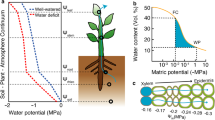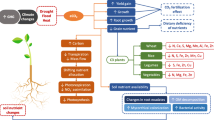Abstract
A pot experiment was conducted in a glasshouse to clarify and quantify the effect of plant part, water regime, growth period, and cultivar on carbon isotope discrimination (CID), and to analyze the relationship between CID, stomatal behavior and water-use efficiency (WUE). The experiment was comprised of two upland rice (Oryza sativa L.) cultivars and three water regimes (100, 70, and 40% of saturation moisture) in a completely randomized design. Plants were harvested at tillering, flowering, and maturity. No significant cultivar differences in above-ground dry matter-based WUE (WUEA) and total dry matter-based WUE (WUET) were observed. WUEA (and WUET) increased with water stress up to tillering, but decreased with water stress after tillering. Significant cultivar differences in CID in all the analyzed plant parts were observed at all harvest times. Reduction in CID with water stress was greatest at tillering, and the effect was less pronounced at flowering and at maturity. At each harvest, the effect was most pronounced in newly developed plant parts. Root and grain tended to have the lowest CID values, and stem the highest, at all harvest times. A negative relationship was observed between CID measured at tillering and WUEA (and WUET) measured over the period from seedling to tillering, whereas a reverse relationship was obtained between CID measured at flowering and WUEA (and WUET) measured over the period from tillering to flowering, and an unclear relationship between CID measured at maturity and WUEA (and WUET) measured over the period from flowering to maturity. The ratio of the intercellular and atmospheric concentration of CO2 (Ci/Ca) were closely associated with CID throughout the water regimes when one cultivar was considered, however, cultivar differences in CID were not related to variations in Ci/Ca. The results indicate that significant cultivar difference existed in CID in all the analyzed plant parts at all harvest times, while corresponding difference in WUEA (and WUET) between the cultivars was not necessarily consistent.
Abbreviations: WUE – water-use efficiency; WUEi – instantaneous WUE (or leaf transpiration efficiency); ADM – above-ground dry matter; TDM – total dry matter; WUEA– ADM-based WUE; WUET– TDM-based WUE} CID – carbon isotope discrimination; NL – the newest leaves; FEL – recently fully expanded leaves; FL – flag leaves; P – photosynthesis rate; g – leaf stomatal conductance to water vapor; Ci– intercellular CO2 concentration; Ca– atmospheric CO2 concentration; T – transpiration rate; gs – total conductance of CO2
Similar content being viewed by others
References
Ares A and Fownes J H 1999 Water supply regulates structure, productivity, and water use efficiency of Acacia koa forest in Hawaii. Oecologia 121, 458–466.
Barrett D J and Gifford R M 1995 Acclimation of photosynthesis and growth by cotton to elevated CO2: Interaction with Severe Phosphate Deficiency and restricted rooting volume. Aust. J. Plant Physiol. 22, 955–963.
Bolton F E 1981 Optimizing the use of water and nitrogen through soil and crop management. In Soil Water and Nitrogen in Mediterranean-type Environments. Eds. J Monteith and C Webb. pp. 231–247. Martinus Nijhoff, The Netherlands.
Brück H, Payne W A and Sattelmacher B 2000 Effects of phosphorus and water supply on yield, transpirational water-use efficiency, and carbon isotope discrimination of Pearl Millet. Crop Sci. 40, 120–125.
Brugnoli E and Farquhar G D 2000 Photosynthetic fractionation of carbon isotopes. In Photosynthesis: Physiology and Metabolism. Eds. R C Leegood, T D Sharkey and S von Caemmerer. pp. 352–434. Kluwer Academic Publishers, Dordrecht, The Netherlands.
Condon A G, Richards R A and Farquhar G D 1992 The effect of variation in soil water availability, vapour pressure deficit and nitrogen nutrition on carbon isotope discrimination in wheat. Aust. J. Agric. Res. 43, 935–947.
Condon A G, Richards R A and Farquhar G D 1993 Relationship between carbon isotope discrimination, water use efficiency and transpiration efficiency for dryland wheat. Aust. J. Agric. Res. 44, 1693–1711.
Dingkuhn M, Farquhar G D, De Datta S K and O'Toole J C 1991 Discrimination of 13C among upland rices having different water use efficiency. Aust. J. Argri. Res. 42, 1123–1131.
Ehdaie B, Hall A E, Farquhar G D, Nguyen H T and Waines J G 1991 Water-use efficiency and carbon isotope discrimination in wheat. Crop Sci. 31, 1282–1288.
Ehdaie B and Waines J G 1993 Variation in water-use efficiency and its components in wheat: I. Well-watered pot experiment. Crop Sci. 33, 294–299.
Ehdaie B 1995 Variation in water-use efficiency and its components in wheat: II. Pot and field experiment. Crop Sci. 35, 1617–1626.
Farquhar G D, O'Leary M H and Berry J A 1982 On the relationship between carbon isotope discrimination and the intercellular carbon dioxide concentration in leaves. Aust. J. Plant Physiol. 9, 121–137.
Farquhar G D and Richards R A 1984 Isotopic composition of plant carbon correlates with water-use efficiency of wheat genotypes. Aust. J. Plant Physiol. 11, 539–552.
Farquhar G D, Ehleringer J R and Hubick K T 1989 Carbon isotope discrimination and photosynthesis. Annu. Rev. Plant Physiol. Plant Mol. Biol. 40, 503–537.
Frank A B and Berdahl J D 2001 Gas exchange and water relations in Diploid and Tetraploid Russian Wildrye. Crop Sci. 41, 87–92.
Hall A E, Mutters R G, Hubick K T and Farquhar G D 1990 Genotypic differences in carbon isotope discrimination by cowpea under wet and dry field conditions. Crop Sci. 30, 300–305.
Hall A E, Richards R A, Condon A G, Wright G C and Farquhar G D 1994 Carbon isotope discrimination and plant breeding. Plant Breed. Rev. 12, 81–113.
Hubick K and Farquhar G 1989 Carbon isotope discrimination and the ratio of carbon gained to water lost in barley cultivars. Plant Cell Environ. 12, 795–804.
IRRI 1997 Rice almanac. IRRI, Manila, Philippines.
Ismail A M and Hall A E 1993 Inheritance of carbon isotope discrimination and water-use efficiency in cowpea. Crop Sci. 33, 498–503.
Jefferies R A and MacKerron D K L 1997 Carbon isotope discrimination in irrigated and droughted potato (Solanum tuberosum L.). Plant Cell Environ. 20, 124–130.
Johnson R C 1993 Carbon isotope discrimination, water relations, and photosynthesis in Tall Fescue. Crop Sci. 33, 169–174.
Kondo M, Pablico P P, Aragones D V and Agbisit R 2002 Effect of genotype, soil water, and N on the variation in 13C discrimination in tropical rice varieties. Jpn J Crop Sci. 71 Extra issue 2, 164–165.
Li C 1999 Carbon isotope composition, water-use efficiency and biomass productivity of Eucalyptus microtheca populations under different water supplies. Plant Soil 214, 165–171.
Lucero D W, Grieu P and Guckert A 2000 Water deficit and plant competition effects on growth and water-use efficiency of white clover (Trifolium repens L.) and ryegrass (Lolium perenne L.). Plant Soil 227, 1–15.
Martin B, Tauer C G and Lin R K 1999 Carbon isotope discrimination as a tool to improve water-use efficiency in tomato. Crop Sci. 39, 1775–1783.
Matus A, Slinkaed A E and Kessel C V 1995 Carbon-13 isotope discrimination at several growth stages in lentil, spring wheat and canola. Can. J. Plant Sci. 75, 577–581.
Meinzer F C, Rundel P W, Goldstein G and Sharifi M R 1992 Carbon isotope composition in relation to leaf gas exchange and environmental conditions in Hawaiian Metrosideros polymorpha populations. Oecologia 91, 305–311.
Merah O, Deléens E and Monneveux P 1999 Grain yield, carbon isotope discrimination, mineral and silicon content in durum wheat under different precipitation regimes. Physiol. Plant. 107, 387–394.
Passioura J B 1977 Grain yield, harvest index, and water use of wheat. J. Aust. Inst. Agric. Sci. 43, 117–120.
Ray I M, Townsend M S and Muncy C M 1999 Heritabilities and interrelationships of water-use efficiency and agronomic traits in irrigated alfalfa. Crop Sci. 39, 1088–1092.
Read J J, Johnson D A, Asay K H and Tieszen L L 1991 Carbon isotope discrimination, gas exchange, and water-use efficiency in crested wheatgrass clones. Crop Sci. 31, 1203–1208.
Rebetzke G J, Condon A G, Richards R A and Farquhar G D 2002 Selection for reduced carbon isotope discrimination increases aerial biomass and grain yield of rainfed bread wheat. Crop Sci. 42, 739–745.
Saranga Y, Flash I, Paterson A H and Yakir D 1999 Carbon isotope ratio in cotton varies with growth stage and plant organ. Plant Sci. 142, 47–56.
Scartazza A, Lauteri M, Guido M C and Brugnoli E 1998 Carbon isotope discrimination in leaf and stem sugars, water-use efficiency and mesophyll conductance during different developmental stages in rice subjected to drought. Aust. J. Plant Physiol. 25, 489–498.
Sun Z J, Livingston N J, Guy R D and Ethier G J 1996 Stable carbon isotopes as indicators of increased water use efficiency and productivity in white spruce (Picea glauca (Moench) Voss) seedlings. Plant Cell Environ. 19, 887–894.
Walley F L, Lafond G P, Matus A and Kessel C van 1999 Water-Use efficiency and carbon isotopic composition in reduced tillage systems. Soil Sci. Soc. Am. J. 63, 356–361.
Rights and permissions
About this article
Cite this article
Zhao, B., Kondo, M., Maeda, M. et al. Water-use efficiency and carbon isotope discrimination in two cultivars of upland rice during different developmental stages under three water regimes. Plant and Soil 261, 61–75 (2004). https://doi.org/10.1023/B:PLSO.0000035562.79099.55
Issue Date:
DOI: https://doi.org/10.1023/B:PLSO.0000035562.79099.55




